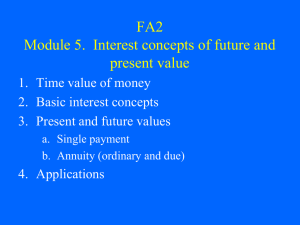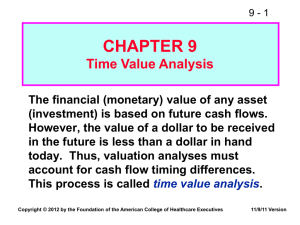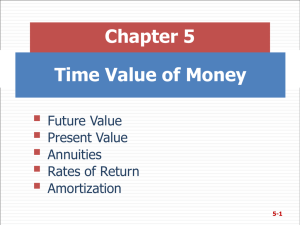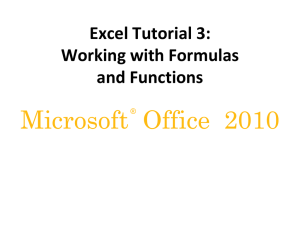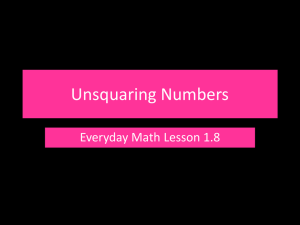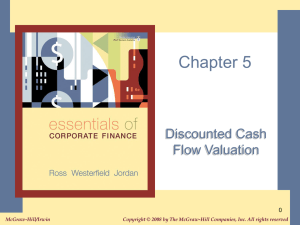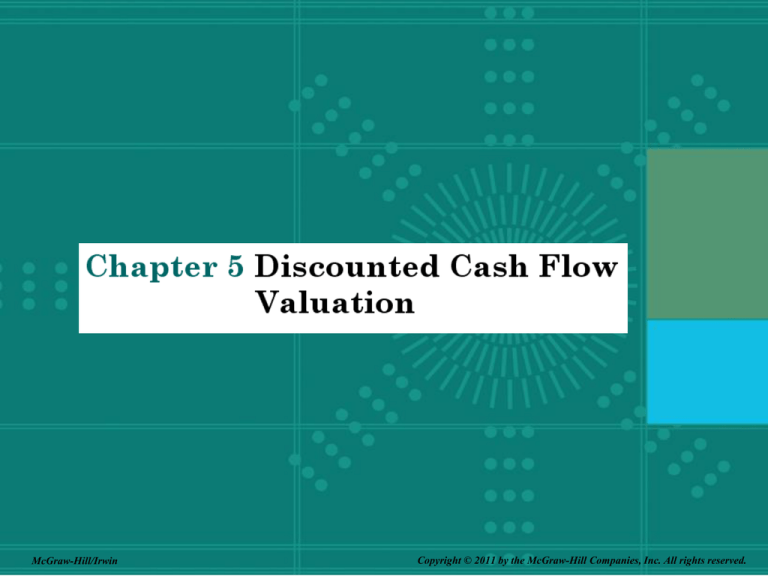
5-1
McGraw-Hill/Irwin
Copyright © 2011 by the McGraw-Hill Companies, Inc. All rights reserved.
Key Concepts and Skills
• Be able to compute the future value of
multiple cash flows
• Be able to compute the present value of
multiple cash flows
• Be able to compute loan payments
• Be able to find the interest rate on a loan
• Understand how loans are amortized or
paid off
• Understand how interest rates are quoted
5-2
Chapter Outline
5.1 Future and Present Values of
Multiple Cash Flows
5.2 Valuing Level Cash Flows:
Annuities and Perpetuities
5.3 Comparing Rates: The Effect of
Compounding Periods
5.4 Loan Types and Loan Amortization
5-3
Multiple Cash Flows
Computational Methods
• TVM Formulas
• Texas Instruments BA II+
– PV/FV keys
– CashFlow Worksheet
• Present Value only
• Excel Spreadsheet/Functions
5-4
Future Value: Multiple Cash Flows
Example 5.1
• You think you will be able to deposit
$4,000 at the end of each of the next three
years in a bank account paying 8 percent
interest.
• You currently have $7,000 in the account.
• How much will you have in 3 years?
• How much in 4 years?
5-5
Future Value: Multiple Cash Flows
Example 5.1 - Formulas
• Find the value at year 3 of each cash
flow and add them together.
– Year 0: FV = $7,000(1.08)3
= $ 8,817.98
– Year 1: FV = $4,000(1.08)2
= $ 4,665.60
– Year 2: FV = $4,000(1.08)1
= $ 4,320.00
– Year 3: value
= $ 4,000.00
– Total value in 3 years
= $21,803.58
• Value at year 4 = $21,803.58(1.08)= $23,547.87
Calculator and Excel Solution
5-6
Future Value: Multiple Cash Flows
Example 5.2
• If you deposit $100 in one year, $200 in two
years and $300 in three years.
• How much will you have in three years at 7
percent interest?
• How much in five years if you don’t add
additional amounts?
–
–
–
–
–
Year 1 CF: 2 ,; 100 S.; 7 -; %0 = 114.49
Year 2 CF: 1 ,; 200 S.; 7 -; %0 = 214.00
Year 3 CF: 0 ,; 300 S.; 7 -; %0 = 300.00
Total FV3
= 628.49
Total FV5 = 628.49 * (1.07)2 = 719.56
5-7
Future Value: Multiple Uneven Cash Flows
Example 5.2 – Formulas & Time Line
TIMELINE
0
1
2
3
4
-$100.00
-$200.00
-$300.00
5
7%
$300.00
200*(1.07) =
$214.00
100*(1.07)^2 =
$114.49
$628.49
Total interest = $628.49-600=28.49
* (1.07)^2 =
$719.56
5-8
Future Value: Multiple Cash Flows
Example 5.2
Rate
Year
1
2
3
7%
Nper
2
1
0
Total FV at Year 3
Total FV at Year 5
CF
-100
-200
-300
FV
$114.49
$214.00
$300.00
Function
=FV(0.07,2,0,-100)
=FV(0.07,1,0,-200)
=FV(0.07,0,0,-300)
$628.49
$719.56
=(628.49)*(1.07)^2
5-9
Future Value: Multiple Cash Flows
Example
• Suppose you invest $500 in a mutual
fund today and $600 in one year.
• If the fund pays 9% annually, how much
will you have in two years?
FV =
$ 500 x (1.09)2 = $ 594.05
+ $ 600 x (1.09) = $ 654.00
= $1,248.05
5-10
Example Continued
• How much will you have in 5 years if you
make no further deposits?
• First way:
FV = $500(1.09)5 + $600(1.09)4 = $1,616.26
• Second way – use value at year 2:
FV = $1,248.05(1.09)3 = $1,616.26
Calculator and Excel Solution
5-11
Future Value: Multiple Cash Flows
Example 3 - Formula
• Suppose you plan to deposit $100 into
an account in one year and $300 into
the account in three years.
• How much will be in the account in five
years if the interest rate is 8%?
FV = $100(1.08)4 + $300(1.08)2 = $136.05 +
$349.92 = $485.97
Calculator and Excel Solution
5-12
Example 3 Time Line
0
1
$100
2
3
4
5
$300
X (1.08)2 =
X (1.08)4 =
$349.92
$136.05
$485.97
5-13
Present Value: Multiple Cash Flows
Example 5.3
– You are offered an investment that will
pay
• $200 in year 1,
• $400 the next year,
• $600 the following year, and
• $800 at the end of the 4th year.
• You can earn 12% on similar investments.
• What is the most you should pay for this one?
5-14
Present Value: Multiple Cash Flows
Example 5.3 - Formula
Find the PV of each cash flow and add
them:
– Year 1 CF: $200 / (1.12)1 = $ 178.57
– Year 2 CF: $400 / (1.12)2 = $ 318.88
– Year 3 CF: $600 / (1.12)3 = $ 427.07
– Year 4 CF: $800 / (1.12)4 = $ 508.41
– Total PV
= $1,432.93
Calculator and Excel Solution
5-15
Example 5.3 Time Line
0
1
2
3
4
Time
(years)
200
400
600
800
178.57
318.88
427.07
508.41
= 1/(1.12)2 x
= 1/(1.12)3 x
= 1/(1.12)4 x
1,432.93
5-16
Multiple Uneven Cash Flows
Using the TI BAII’s Cash Flow Worksheet
• Clear all:
– Press'
– Then &
– Then z
• CF0 is displayed as 0.00
• Enter the Period 0 cash flow
– If an outflow, press S to change
the sign
• To enter the figure in the cash
flow register, press !
5-17
TI BAII+: Uneven Cash Flows
• Press the down arrow # to
move to the next cash flow
register
• Enter the cash flow amount,
press ! and # to move to the
cash flow counter (Fnn)
• The default counter value is “1”
– To accept the value of “1”, press
the down arrow again
– To change the counter, enter the
correct count, press ! and then
#
5-18
TI BAII+: Uneven Cash Flows
• Repeat for all cash flows, in
order.
• To find NPV:
– Press (: I appears on the screen
– Enter the interest rate, press !
and # to display NPV.
– Press %
5-19
TI BAII+: Uneven Cash Flows
Cash Flows:
CF0
=
0
CF1
=
200
CF2
=
400
CF3
=
600
CF4
=
800
Display
You Enter
'
C00
C01
F01
C02
F02
C03
F03
C04
F04
I
NPV
0 !#
200 !#
1 !#
400 !#
1 !#
600 !#
1 !#
800 !#
1 !# (
12 !#
%
1432.93
Excel Solution
5-20
Present Value: Multiple Cash Flows
Another Example – Formula Solution
• You are considering an investment that will
pay you $1,000 in one year, $2,000 in two
years and $3,000 in three years.
• If you want to earn 10% on your money,
how much would you be willing to pay?
PV = $1,000 / (1.1)1
PV = $2,000 / (1.1)2
PV = $3,000 / (1.1)3
PV
= $ 909.09
= $1,652.89
= $2,253.94
= $4,815.92
Calculator and Excel Solution
5-21
Decisions, Decisions
• Your broker calls you and tells
you that he has this great
investment opportunity.
• If you invest $100 today, you
will receive $40 in one year
and $75 in two years.
• If you require a 15% return on
investments of this risk, should
you take the investment?
Use cash flow keys:
'
&z
CF0
0 !#
C01
40 !#
F01
1 !#
C02
75 !#
F02
1 !#
(
I
15 !#
%
91.49
• No – the broker is charging
more than you would be willing
to pay.
5-22
Saving For Retirement
• You are offered the opportunity to put some
money away for retirement. You will receive
five annual payments of $25,000 each
beginning in 40 years.
Use cash flow keys:
How much would you
be willing to invest
today if you desire an
interest rate of 12%?
'
&z
CF0
0 !#
C01
0 !#
F01
39 !#
C02
25000 !#
F02
5 !#
(
I
12 !#
%
1084.71
5-23
Saving For Retirement Timeline
0 1 2
…
39
40
41
42
43
44
0 0 0
…
0
25K
25K
25K
25K
25K
Notice that the year 0 cash flow = 0 (CF0 = 0)
Cash flows years 1–39 = 0
(C01 = 0; F01 = 39)
Cash flows years 40–44 = 25,000
(C02 = 25,000; F02 = 5)
5-24
Quick Quiz – Part 1
• Suppose you are looking at the following
possible cash flows:
– Year 1 CF = $100;
– Years 2 and 3 CFs = $200;
– Years 4 and 5 CFs = $300.
– The required discount rate is 7%
• What is the value of the CFs at year 5?
• What is the value of the CFs today?
Calculator Solution
5-25
Quick Quiz 1 – Excel Solution
A
1
2
3
4
5
6
7
8
9
B
C
D
Chapter 5 - Quick Quiz 1
Rate
7%
Year Nper
CF
PV
1
1
100
$93.46
2
2
200
$174.69
3
3
200
$163.26
4
4
300
$228.87
5
5
300
$213.90
Total PV
$874.17
E
Formula
=-PV($C$2,A4,0,C4)
=-PV($C$2,A5,0,C5)
=-PV($C$2,A6,0,C6)
=-PV($C$2,A7,0,C7)
=-PV($C$2,A8,0,C8)
=SUM(C4:C8)
10
11
12
13
14
15
16
17
Year Nper
1
4
2
3
3
2
4
1
5
0
CF
100
200
200
300
300
Total FV
FV
$131.08
$245.01
$228.98
$321.00
$300.00
$1,226.07
Year
=-FV($C$2,B12,0,C12)
=-FV($C$2,B13,0,C13)
=-FV($C$2,B14,0,C14)
=-FV($C$2,B15,0,C15)
=-FV($C$2,B16,0,C16)
=SUM(C12:C16)
5-26
Chapter 5 – Quick Quiz 1
$
$
$
$
$
$
874.12
213.90
228.87
163.26
174.69
93.46
PV
7%
Period
0
1
2
3
4
5
CFs
0
100
200
200
300
300
FV =
$
300.00
$
321.00
$
228.98
$
245.01
$
131.08
$ 1,226.07
5-27
Annuities and Perpetuities
• Annuity – finite series of equal payments
that occur at regular intervals
– If the first payment occurs at the end of the
period, it is called an ordinary annuity
– If the first payment occurs at the beginning of
the period, it is called an annuity due
• Perpetuity – infinite series of equal
payments.
5-28
Annuities and Perpetuities
Basic Formulas
• Perpetuity: PV = PMT / r
• Annuities:
1
1 (1 r ) t
PV PMT
r
(1 r ) t 1
FV PMT
r
5-29
Annuities and the Calculator
• The / key on the calculator is used for
the equal payment
• The sign convention still holds
• Ordinary annuity versus Annuity due
– Switch your calculator between the two
types (next slide)
– If you see “BGN” or “Begin” in the display
of your calculator, you have it set for an
annuity due
– Most problems are ordinary annuities
5-30
TI BAII+:
Set Annuity Time Value Parameters
• Set END for an ordinary annuity or BGN
for an annuity due
– Press &
] (above /)
– This is a toggle switch. The default is END.
– To change to BEGIN, press &V (above !)
to go back and forth.
– Press &U to set the displayed choice.
5-31
Excel Spreadsheet Functions
–
–
–
–
–
FV(Rate,Nper,Pmt,PV,0/1)
PV(Rate,Nper,Pmt,FV,0/1)
RATE(Nper,Pmt,PV,FV,0/1)
NPER(Rate,Pmt,PV,FV,0/1)
PMT(Rate,Nper,PV,FV,0/1)
• Inside parens: (RATE,NPER,PMT,PV,FV,0/1)
• “0/1” Ordinary annuity = 0 (default; no entry needed)
Annuity Due = 1 (must be entered)
5-32
Important Points to Remember
• Interest rate and time period must
match!
– Annual periods annual rate
– Monthly periods monthly rate
• The Sign Convention
– Cash inflows are positive
– Cash outflows are negative
5-33
Sign Convention Example
5
,
10
100 S.
20
/
%0 = $38.95
Implies you deposited
$100 today and plan to
WITHDRAW $20 a year
for 5 years
+CF = Cash INFLOW to YOU
5
,
10
100 S.
20
S/
%0 = $283.15
Implies you deposited
$100 today and plan to
ADD $20 a year for 5
years
-CF = Cash OUTFLOW from you
5-34
Annuity
Example 5.5
• You can afford $632
per month.
• Going rate = 1%/month
for 48 months.
• How much can you
borrow?
• You borrow money
TODAY so you need to
compute the present
value.
48 ,
1 632 S/
0 0
%. = 23,999.54
($24,000)
1
1
48
( 1 . 01 )
PV 632
. 01
23 , 999 . 54
=PV(0.01,48,-632,0)
5-35
Annuity – Sweepstakes
Example
• Suppose you win the Publishers
Clearinghouse $10 million sweepstakes.
• The money is paid in equal annual
installments of $333,333.33 over 30 years.
• If the appropriate discount rate is 5%, how
much is the sweepstakes actually worth
today?
PV = $333,333.33[1 – 1/1.0530] / .05 =
$5,124,150.29
Calculator and Excel Solution
5-36
Buying a House
• You are ready to buy a house and you have $20,000 for
a down payment and closing costs.
• Closing costs are estimated to be 4% of the loan value.
• You have an annual salary of $36,000.
• The bank is willing to allow your monthly mortgage
payment to be equal to 28% of your monthly income.
• The interest rate on the loan is 6% per year with monthly
compounding (.5% per month) for a 30-year fixed rate
loan.
• How much money will the bank loan you?
• How much can you offer for the house?
5-37
Buying a House - Continued
• Bank loan
– Monthly income = 36,000 / 12 = 3,000
– Maximum payment = .28(3,000) = 840
• 360 ,
(30*12)
• 0.5 =PV(.005,360,-840,0)
• 840 S/
%. = 140,105
• Total Price
– Closing costs = .04(140,105) = 5,604
– Down payment = 20,000 – 5604 = 14,396
– Total Price = 140,105 + 14,396 = 154,501
5-38
Quick Quiz – Part 2
• You know the payment amount for a loan
and you want to know how much was
borrowed.
– Do you compute a present value or a future
value?
5-39
Quick Quiz – Part 2
• You want to receive $5,000 per month in
retirement. If you can earn .75% per
month and you expect to need the income
for 25 years, how much do you need to
have in your account at retirement?
– 300 ,
Months
– 0.75 Monthly rate
– 5000 /
Monthly Payment
–0
0
=PV(0.0075,300,5000,0)
%. -595,808.11
5-40
Finding the Payment
• Suppose you want to
borrow $20,000 for a
4(12) = 48 ,
new car.
0.66667 • You can borrow at 8%
20,000
.
per year, compounded
0
0
monthly (8/12 =
%/ = - 488.26
.66667% per month).
• If you take a 4 year loan,
what is your monthly
=PMT(0.006667,48,20000,0)
payment?
5-41
Finding the Number of Payments
Example 5.6
•
•
•
•
$1,000 due on credit card
Payment = $20 month minimum
Rate = 1.5% per month
The sign convention matters!!!
1.5
1000 .
20
S/
0
0
%, = 93.111 months
= 7.75 years
=NPER(0.015,-20,1000,0)
5-42
Finding the Number of Payments
Another Example
• Suppose you borrow $2,000 at 5% and
you are going to make annual payments of
$734.42. How long before you pay off the
loan?
5
2000 .
734.42 S/
0
0
%, = 3 years
=NPER(0.05,-734.42,2000,0)
5-43
Finding the Rate
• Suppose you borrow $10,000 from your
parents to buy a car. You agree to pay
$207.58 per month for 60 months. What is
the monthly interest rate?
60
,
10000 .
207.58 S/
0
0
%- =.75%
=RATE(60,-207.58,10000,0)
5-44
Quick Quiz – Part 3
• You want to receive $5,000 per month for
the next 5 years. How much would you
need to deposit today if you can earn .75%
per month?
60
,
0.75
5000 /
0
0
%. = -240866.87
=PV(0.0075,60,5000,0)
5-45
Quick Quiz – Part 3
• You want to receive $5,000 per month for
the next 5 years.
• What monthly rate would you need to earn
if you only have $200,000 to deposit?
60
,
200000 S.
5000 /
0
0
%- = 1.4395%
=RATE(60,5000,-200000,0)
5-46
Quick Quiz – Part 3
• Suppose you have $200,000 to deposit
and can earn .75% per month.
– How many months could you receive the
$5,000 payment?
0.75
200000 S.
5000 /
0
0
%, = 47.73 months
≈ 4 years
=NPER(0.0075,5000,-200000,0)
5-47
Quick Quiz – Part 3
• Suppose you have $200,000 to deposit and can
earn .75% per month.
– How much could you receive every month for 5
years?
60
,
0.75
200000 S.
0
0
%/ = 4151.67
=PMT(0.0075,60,-200000,0)
5-48
Future Values for Annuities
• Suppose you begin saving for your retirement by
depositing $2,000 per year in an IRA. If the
interest rate is 7.5%, how much will you have in
40 years?
40
,
7.5
0
.
2000 S/
%0 = 454513.04
=FV(0.075,40,-2000,0)
(1 r ) t 1
FV PMT
r
(1 . 075 ) 40 1
FV 2000
454 ,513 . 04
.
075
5-49
Annuity Due
• You are saving for a new house and you put
$10,000 per year in an account paying 8%. The
first payment is made today. How much will you
have at the end of 3 years?
&]&V&U
3
,
8
0
.
10000 S/
%0 = 35061.12
&]&V&U
=FV(0.08,3,-10000,0,1)
FV AD
(1 r ) t 1
PMT
(1 r )
r
FV AD
(1 . 08 ) 3 1
10000
(1 . 08 ) 35 ,061 . 12
.
08
Reset to END
5-50
Table 5.2
5-51
Example: Work the Web
• Another online financial calculator can
be found at Calculatoredge.com.
• Click on the Web surfer, select
“Finance” calculator and “Annuity
Payments” and work the following
example:
– How much could you withdraw each year
if you have $2,500,000, earn 8 % and
make annual withdrawals for 35 years?
5-52
Perpetuity
Example 5.7
• Perpetuity formula: PV = PMT / r
• Current required return:
– 40 = 1 / r
– r = .025 or 2.5% per quarter
• Dividend for new preferred:
– 100 = PMT / .025
– PMT = 2.50 per quarter
5-53
Quick Quiz – Part 4
• You want to have $1 million to use for retirement
in 35 years. If you can earn 1% per month, how
much do you need to deposit on a monthly basis
if the first payment is made in one month?
Ordinary Annuity
420
,
1
0
.
1000000 0
%/ = -155.50
=PMT(0.01,420,0,1000000)
5-54
Quick Quiz – Part 4
• You want to have $1 million to use for retirement
in 35 years. If you can earn 1% per month, how
much do you need to deposit on a monthly basis
if the first payment is made today?
&]&V&U
420
,
1
0
.
1000000
0
%/ = -153.96
&]&V&U
Annuity Due
=PMT(0.01,420,0,1000000,1)
5-55
Quick Quiz – Part 4
• You are considering preferred stock that
pays a quarterly dividend of $1.50. If your
desired return is 3% per quarter, how
much would you be willing to pay?
$1.50/0.03 = $50
5-56
Interest Rates
• Effective Annual Rate (EAR)
– The interest rate expressed as if it were compounded
once per year.
– Used to compare two alternative investments with
different compounding periods
• Annual Percentage Rate (APR) “Nominal”
– The annual rate quoted by law
– APR = periodic rate X number of periods per year
– Periodic rate = APR / periods per year
Return to
Quick Quiz
5-57
Things to Remember
• You ALWAYS need to make sure that the interest
rate and the time period match.
– Annual periods annual rate.
– Monthly periods monthly rate.
• If you have an APR based on monthly
compounding, you have to use monthly periods
for lump sums or adjust the interest rate
accordingly.
5-58
EAR Formula
APR
EAR 1
m
m
1
APR = the quoted rate
m = number of compounds per year
5-59
EAR and APR in TI BA II+
&v
&z
• 3 fields in worksheet:
– NOM (Nominal rate-APR)
– EFF (Effective annual rate)
– C/Y (Compounding periods/yr)
#
#
#
– Enter any 2 values, move to the 3rd and press %
5-60
EAR and NOM in Excel
• 2 Functions:
=EFFECT(Nom, Nper)
=NOMINAL(Eff, Nper)
• All rates entered as decimals
• Nper = number of compounding periods
per year
TOOLS … Add-Ins … ANALYSIS TOOLPAK
5-61
Decisions, Decisions
• Which savings accounts should you choose:
– 5.25% with daily compounding.
– 5.30% with semiannual compounding.
• First account:
• EAR = (1 + .0525/365)365 – 1
&v: NOM=5.25; C/Y=365
• =EFFECT(0.525,365)
= 5.39%
EFF=5.3899
• Second account:
• EAR = (1 + .053/2)2 – 1
&v: NOM=5.3; C/Y=2
• =EFFECT(0.53,2)
= 5.37%
EFF=5.3702
5-62
Computing APRs
• What is the APR if the monthly rate is .5%?
.5%(12) = 6%
• What is the APR if the semiannual rate is
.5%?
.5%(2) = 1%
• What is the monthly rate if the APR is 12%
with monthly compounding?
12% / 12 = 1%
Can you divide the above APR by 2 to get the
semiannual rate?
NO. You need an APR based on semiannual
compounding to find the semiannual rate.
5-63
Computing EAR and APR
• Suppose you can earn 1% per month on $1
invested today.
– What is the APR? 1(12) = 12%
– How much are you effectively earning?
• FV = 1(1.01)12 = 1.1268
• Rate = (1.1268 – 1) / 1 = .1268 = 12.68%
&v:
NOM
C/Y
EFF %
= 12
#
= 12
#
= 12.6825
=EFFECT(0.12,12)
5-64
Computing EAR and APR
• Suppose if you put it in another account, you
earn 3% per quarter.
– What is the APR? 3(4) = 12%
– How much are you effectively earning?
• FV = 1(1.03)4 = 1.1255
• Rate = (1.1255 – 1) / 1 = .1255 = 12.55%
&v:
NOM
C/Y
EFF %
= 12
#
=4
#
= 12.5509
=EFFECT(0.12,4)
5-65
Computing APRs from EARs
APR m (1 EAR)
1
m
-1
M = number of compounding periods per year
5-66
APR - Example
• Suppose you want to earn an effective rate of
12% and you are looking at an account that
compounds on a monthly basis. What APR
must they pay?
APR 12 (1 . 12 )
&v: EFF
1 / 12
1 . 113 8655 or 11.39%
= 12
#
C/Y
= 12
#
NOM %
= 11.3866
=NOMINAL(0.12,12)
5-67
Computing Payments with APRs
• Suppose you want to buy a new computer.
• The store is willing to allow you to make monthly
payments.
• The entire computer system costs $3,500.
• The loan period is for 2 years.
• The interest rate is 16.9% with monthly compounding.
• What is your monthly payment?
2(12)
= 24 ,
16.9 / 12 = 1.40833 3500 .
00
%/
= -172.88
=PMT(0.0140833,24,3500,0)
5-68
Future Values
with Monthly Compounding
• Suppose you deposit $50 a month into an
account that has an APR of 9%, based on
monthly compounding. How much will you have
in the account in 35 years?
420 , (35*12)
0.75 (9/12)
0
.
-50 /
%0 = 147,089.22
=FV(0.0075,420,-50,0)
5-69
Present Value with Daily
Compounding
• You need $15,000 in 3 years for a new car. If
you can deposit money into an account that
pays an APR of 5.5% based on daily
compounding, how much would you need to
deposit?
1095
, (3*365)
.015068493 - (5.5/365)
0
/
15,000
0
%. = -12,718.56
=PV(0.00015,1095,0,15000)
5-70
Quick Quiz: Part 5
• What is the definition of an APR?
• What is the effective annual rate?
• Which rate should you use to compare
alternative investments or loans?
• Which rate do you need to use in the
time value of money calculations?
(Answers = Slide 5.56)
5-71
Pure Discount Loans
• Treasury bills are excellent examples of pure
discount loans.
– Principal amount is repaid at some future date
– No periodic interest payments
• If a T-bill promises to repay $10,000 in 12
months and the market interest rate is 7 percent,
how much will the bill sell for in the market?
– 1 ,; 10,000 0; 7 -; %. = -9345.79
– =PV(.07,1,0,10000)
Return to
Quick Quiz
5-72
Amortized Loan with Fixed Payment
Example
• Each payment covers the interest expense
plus reduces principal
• Consider a 4-year loan with annual
payments. The interest rate is 8% and the
principal amount is $5000.
– What is the annual payment?
• 5,000 = PMT[1 – 1 / 1.084] / .08 PMT = 1,509.60
• =PMT(0.08,4,5000,0) = 1509.60
• 4 ,; 8 -; 5000 ., 0 0, %/ = 1509.60
Return to
Quick Quiz
5-73
Amortized Loan with Fixed Payment Example
Year
1
2
3
4
Totals
Beginning
Balance
$ 5,000.00
$ 3,890.40
$ 2,692.03
$ 1,397.79
Total Payment
Payment
$ 1,509.60
$ 1,509.60
$ 1,509.60
$ 1,509.60
$ 6,038.40
$
$
$
$
$
Interest
Paid
400.00
311.23
215.36
111.82
1,038.42
Principal
Ending
Paid
Balance
$ 1,109.60 $ 3,890.40
$ 1,198.37 $ 2,692.03
$ 1,294.24 $ 1,397.79
$ 1,397.79 $
$ 5,000.00
Interest Paid = Beginning Balance * Rate (8%)
Principal Paid = Total Payment – Interest Paid
Ending Balance = Beginning Balance – Principal Paid
5-74
Quick Quiz: Part 6
• What is a pure discount loan?
– What is a good example of a pure
discount loan? (Slide 5.72)
• What is an amortized loan?
– What is a good example of an
amortized loan? (Slide 5.73)
5-75
Example: Work the Web
• Several Web sites have calculators that will
prepare amortization tables quickly
• One such site is Bankrate.com
• Click on the Web surfer, select “Calculators,”
“Mortgage Payment Calculator,” and enter
the following information:
– Loan amount = $20,000
– Term = 10 years
– Interest rate = 7.625%
– What is the monthly payment?
5-76
FV Example 5.1
Calculator Solution
Calculator Solution
,
3
2
1
8
8
8
Value at year 4:
Year
,
4
1
8
Year
0
1
2
3
0
0
0
%
0
8,817.98
4,665.60
4,320.00
4,000.00
21,803.58
.
/
21,803.58
0
0
23,547.87
.
7000
4000
4000
/
Return to
Slideshow 5-77
FV Example 5.1
Excel Solution
Excel Solution
Year Nper
0
3
1
2
2
1
3
Rate
0.08
0.08
0.08
Value at year 4:
Year Nper Rate
4
1
0.08
PV
-7000
-4000
-4000
PMT
0
0
0
FV
8,817.98
4,665.60
4,320.00
4,000.00
21,803.58
PV
-21,803.58
PMT
0
FV
23,547.87
=FV(Rate, Nper,PMT,PV)
Return to
Slideshow
5-78
FV Example 2
Calculator Solution
Year
0
1
,
2
1
Value at year 4:
Year
,
5
3
9
9
.
500
600
/
0
0
%
0
594.05
654.00
1,248.05
9
.
1,248.05
/
0
0
1,616.26
/
0
0
%
0
769.31
846.95
1,616.26
or
Year
0
1
,
5
4
9
9
.
500
600
Return to
Slideshow
5-79
FV Example 2
Excel Solution
Excel Solution
Year
0
1
Nper
2
1
Rate
0.09
0.09
PV
-500
-600
PMT
0
0
FV
594.05
654.00
1,248.05
Value at year 4:
Year
Nper
5
3
Rate
0.09
PV
-1,248.05
PMT
0
FV
1,616.26
=FV(Rate, Nper,PMT,PV)
Return to
5-80
Slideshow
FV Example 3
Calculator & Excel Solution
Calculator Solution
Year
1
3
Excel Solution
Year
1
3
,
4
2
8
8
.
100
300
/
0
0
N
4
2
I/Y
0.08
0.08
PV
-100
-300
PMT
0
0
%
0
136.05
349.92
485.97
FV
136.05
349.92
485.97
=FV(RATE, NPER,PMT,PV)
Return to
5-81
Slideshow
Multiple Cash Flows - Example 5.3
Calculator Solution
Year
1
2
3
4
,
1
2
3
4
12
12
12
12
.
200
400
600
800
/
0
0
0
0
%
0
178.57
318.88
427.07
508.41
1,432.93
Return to
Slideshow 5-82
Multiple Cash Flows - Example 5.3
Excel Solution
Excel Solution
Year Nper
1
1
2
2
3
3
4
4
Rate
0.12
0.12
0.12
0.12
FV
-200
-400
-600
-800
PMT
0
0
0
0
PV
178.57
318.88
427.07
508.41
1,432.93
=PV(Rate, Nper,PMT,FV)
Return to
Slideshow
5-83
Excel – PV of Multiple Uneven CFs
Rate
12%
Period Cash Flow
1
2
3
4
$
$
$
$
200.00
400.00
600.00
800.00
Total PV =
Present
Value
($178.57)
($318.88)
($427.07)
($508.41)
=PV($B$1,A3,0,B3)
=PV($B$1,A4,0,B4)
=PV($B$1,A5,0,B5)
=PV($B$1,A6,0,B6)
($1,432.93)
($1,432.93)
=SUM(C3:C6)
=-NPV(B1,B3:B6)
Formula
The functions require a PMT = 0.
Return to
Slideshow
5-84
Multiple Cash Flows – PV Example
Calculator & Excel Solutions
Calculator Solution
Year
1
2
3
Excel Solution
Year
1
2
3
,
1
2
3
10
10
10
0
1000
2000
3000
/
0
0
0
Nper
1
2
3
Rate
0.10
0.10
0.10
FV
-1000
-2000
-3000
PMT
0
0
0
%
.
909.09
1,652.89
2,253.94
4,815.92
PV
909.09
1,652.89
2,253.94
4,815.93
=PV(Rate, Nper,PMT,FV)
Return to
Slideshow
5-85
Quick Quiz: Part 1
Discount Rate
Year
1
2
3
4
5
7%
CF
100
200
200
300
300
•Easiest to find PV first
•Use resulting PV to
find value in years 3
and 5
Calculator:
I
(
'
0
100
1
200
2
300
3
(
7
%
,
.
/
0%
Year 3
3
7
874.17
0
1070.89
Display
CF0
C01
F01
C02
F02
C03
F03
Keystrokes
&
z
!
#
!
#
!
#
!
#
!
#
!
#
!
#
!
#
874.17
Year 5
5
7
874.17
0
1226.07
Return to
5-86
Slideshow
Annuity – Sweepstakes Example
%
30
5
$ (5,124,150.29)
$ 333,333.33
0
,
.
/
0
=PV(5, 30, 333333.33, 0) =
($5,124,150.29)
Return to
Slideshow
5-87
Chapter 5
END
5-88

